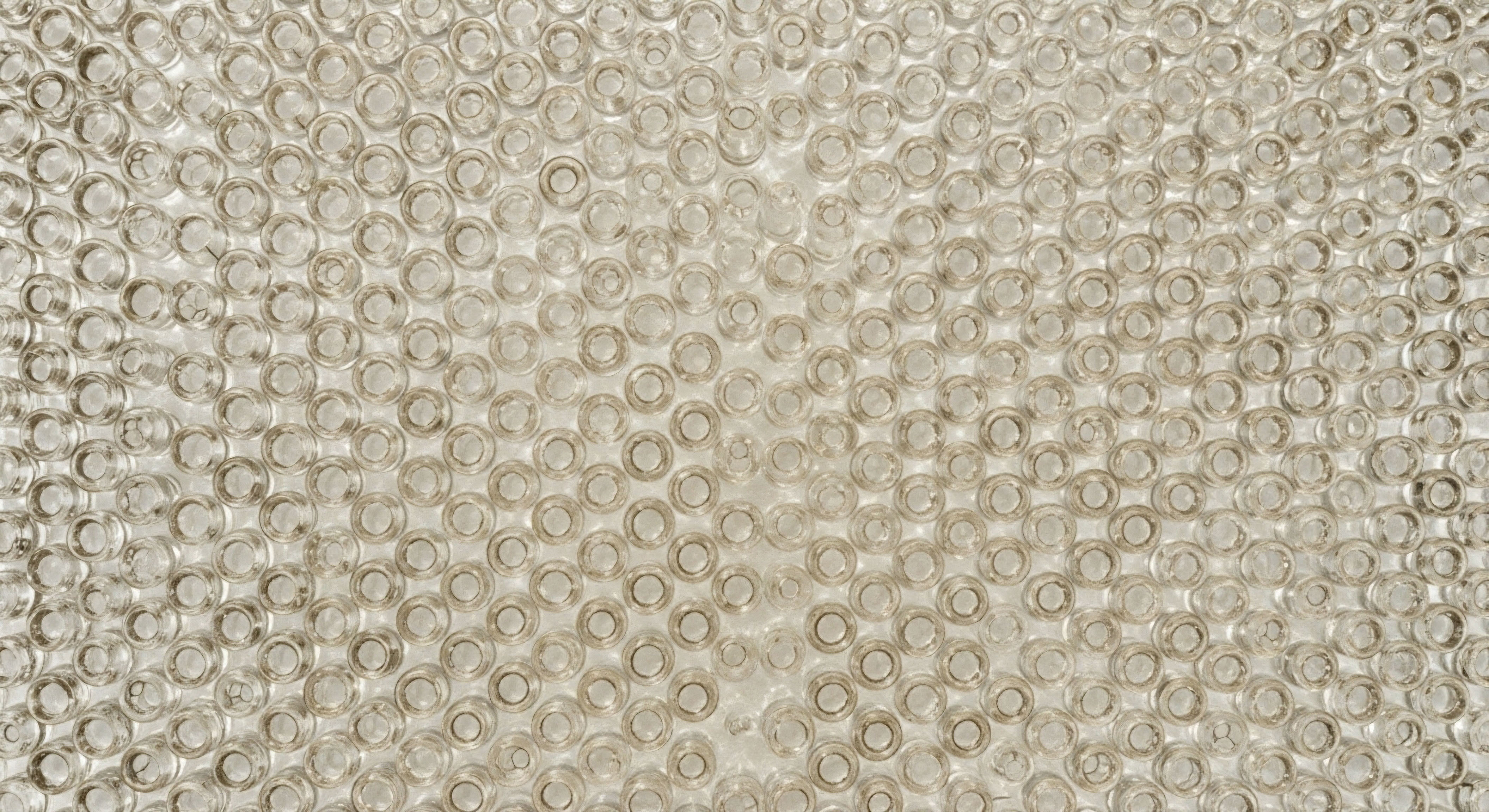

Fundamentals
You feel it as a subtle shift in your body’s internal landscape. The energy that once felt abundant now seems more finite, recovery takes a day longer, and the clarity you once took for granted requires more effort to summon.
This experience, this intimate awareness of change, is the starting point of a profound investigation into your own biology. Your body is communicating a need for a new strategy, a more sophisticated approach to wellness that moves with you through time. The conversation about longevity begins right here, in the quiet recognition that maintaining vitality requires a deliberate and informed partnership with your own cellular systems.
At the heart of this partnership are two powerful concepts that address cellular aging from distinct yet complementary angles ∞ high-intensity exercise and senolytic compounds. Understanding them is the first step toward reclaiming a sense of biological agency. These are not competing ideas; they are different tools in a sophisticated toolkit for personalized health, each addressing a unique aspect of cellular maintenance and renewal.

The Cellular Response to Intense Physical Demand
High-intensity interval training (HIIT) can be understood as a form of constructive dialogue with your cells. Through brief, powerful bursts of exertion, you introduce a significant, controlled stressor to your biological systems. This demand sends a clear and potent signal throughout your body, essentially commanding your cells to adapt and become more resilient.
The primary site of this adaptation is within the mitochondria, the microscopic power plants inside every cell responsible for generating the energy that fuels life itself. As we age, these power plants can become less efficient, producing less energy and more metabolic waste. HIIT acts as a catalyst for a process called mitochondrial biogenesis.
This is the creation of new, more efficient mitochondria. Think of it as a city-wide project to upgrade an aging electrical grid, replacing old, faulty power stations with new, high-output models. The result is a cellular environment with more energy, greater efficiency, and an enhanced capacity to handle stress. This systemic upgrade improves metabolic health, sharpens cognitive function, and builds a deep, cellular foundation for lasting vitality.
High-intensity exercise acts as a powerful signaling event that compels cells to rebuild their energy-producing machinery, leading to systemic improvements in function and resilience.

Clearing the Debris of Cellular Aging
While HIIT focuses on rebuilding and upgrading, a different challenge accumulates within our tissues over time. Certain cells, when faced with overwhelming damage or stress, enter a state of irreversible growth arrest called senescence. These senescent cells, sometimes referred to as ‘zombie cells’, cease to divide and perform their normal functions.
They also resist the body’s natural process of programmed cell death, apoptosis. Instead, they linger, secreting a cocktail of pro-inflammatory molecules known as the Senescence-Associated Secretory Phenotype (SASP).
This constant inflammatory signaling can be likened to a slow, persistent leak of toxins into the cellular neighborhood, disrupting the function of healthy nearby cells and contributing to many of the conditions we associate with aging. It is a form of biological clutter that impairs tissue function and accelerates the aging process.
Senolytic compounds are designed to address this specific problem. They are a class of molecules that can selectively identify and induce apoptosis in these lingering senescent cells. A senolytic acts like a highly specialized cleanup crew, entering a tissue, identifying the dysfunctional cells that are causing chronic disruption, and removing them.
This targeted removal of senescent cells helps to lower the overall inflammatory burden on the body, allowing healthy cells to function in a cleaner, more stable environment. This intervention aims to restore tissue homeostasis and function by removing a key source of age-related biological noise.

Two Distinct Strategies for Cellular Health
These two approaches represent different philosophies of cellular maintenance. High-intensity exercise is a proactive, continuous strategy of building resilience. It is a training regimen for your entire cellular ecosystem, making it stronger, more energy-efficient, and better able to resist damage. Senolytic therapy is a targeted, intermittent intervention.
It is a precision tool used to remove a specific type of cellular damage that has already accumulated. One is a process of fortification; the other is a process of purification. Both contribute to the ultimate goal of extending healthspan, the period of life spent in good health, by addressing the fundamental mechanisms of cellular aging.


Intermediate
To truly appreciate the distinct value of high-intensity exercise and senolytic therapies, we must move beyond broad analogies and examine the specific biochemical pathways they influence. The body’s response to these interventions is a cascade of molecular signals that recalibrates cellular function, hormonal balance, and tissue health. Understanding these mechanisms allows for a more intentional application of each strategy, transforming them from abstract concepts into precise clinical tools for promoting longevity.

HIIT as a Catalyst for Systemic Rejuvenation
The profound effects of high-intensity interval training are initiated at the molecular level through the activation of key metabolic sensors. The intense, short-term energy demand during a HIIT session creates a temporary state of cellular energy deficit. This state is a powerful trigger for adaptation.

Key Molecular Pathways Activated by HIIT
- AMP-Activated Protein Kinase (AMPK) ∞ Think of AMPK as the master metabolic regulator or the cell’s fuel gauge. When cellular energy (in the form of ATP) is rapidly consumed during intense exercise, the ratio of AMP to ATP rises, activating AMPK. Activated AMPK initiates a cascade of events designed to restore energy balance. It stimulates glucose uptake into muscles, increases the oxidation of fatty acids for fuel, and, most importantly for longevity, it triggers both mitochondrial biogenesis and autophagy.
- PGC-1α and Mitochondrial Biogenesis ∞ AMPK activation directly stimulates the expression of Peroxisome proliferator-activated receptor-gamma coactivator 1-alpha (PGC-1α). PGC-1α is the principal driver of mitochondrial biogenesis, the process of creating new mitochondria. A landmark 2017 study in Cell Metabolism demonstrated that HIIT was remarkably effective at reversing age-related decline in mitochondrial function in older adults, showcasing the power of this pathway. More mitochondria mean a greater capacity for energy production and a more robust cellular engine.
- Autophagy and Mitophagy ∞ HIIT also stimulates autophagy, the body’s cellular recycling system. This process breaks down and removes old, damaged, or misfolded proteins and cellular components. A specialized form of this process, known as mitophagy, specifically targets and removes dysfunctional mitochondria. By clearing out damaged power plants while simultaneously building new ones, HIIT ensures the overall quality and efficiency of the cell’s energy infrastructure remain high.
The cellular response to HIIT is an integrated system of renewal, simultaneously building new energy factories through biogenesis and clearing out old ones through mitophagy.
This systemic recalibration extends to the endocrine system. The acute stress of HIIT stimulates the release of key anabolic hormones, including Human Growth Hormone (HGH) and testosterone. These hormones play a vital role in tissue repair, muscle protein synthesis, and maintaining metabolic health, further contributing to the anti-aging effects of the practice.

Senolytics a Precision Strike against Cellular Dysfunction
Senolytic therapy operates on a completely different principle. It is not about building new capacity; it is about surgically removing a source of chronic damage. The target is the senescent cell, and the weapon is a deep understanding of its unique survival mechanisms.

Targeting the Achilles Heel of Senescent Cells
Senescent cells manage to evade apoptosis by upregulating a network of pro-survival pathways. These are collectively known as Senescent Cell Anti-Apoptotic Pathways (SCAPs). Different types of senescent cells in different tissues rely on different combinations of these pathways to stay alive. This dependency is their greatest vulnerability.
The most well-studied senolytic combination, Dasatinib and Quercetin (D+Q), exemplifies this targeted approach:
- Dasatinib ∞ Originally developed as a chemotherapy drug, Dasatinib is a tyrosine kinase inhibitor. In the context of senolysis, it primarily inhibits the BCL-2 family of anti-apoptotic proteins, which are critical for the survival of certain senescent cell populations.
- Quercetin ∞ A natural flavonoid found in many plants, Quercetin inhibits a different set of survival pathways, including the PI3K/Akt pathway.
By combining these two compounds, a broader spectrum of senescent cells can be targeted and eliminated. The therapy works by temporarily disabling these survival pathways, which pushes the senescent cell over the edge into programmed cell death. Healthy cells, which are not so heavily reliant on these specific SCAPs for survival, are largely unaffected.
This “hit-and-run” approach, where the drugs are taken intermittently (e.g. for a few days each month), is sufficient to reduce the burden of senescent cells without causing the side effects associated with continuous administration.

How Do These Cellular Interventions Compare?
Placing these two powerful strategies side-by-side reveals their distinct and potentially synergistic roles in a longevity protocol. One is a foundational practice for building resilience, while the other is a specialized therapy for targeted repair.
| Feature | High-Intensity Interval Training (HIIT) | Senolytic Compounds |
|---|---|---|
| Primary Cellular Mechanism | Induces adaptive stress, leading to mitochondrial biogenesis, autophagy, and mitophagy. | Induces apoptosis (programmed cell death) in senescent cells by inhibiting their survival pathways (SCAPs). |
| Biological Target | Broad, systemic effect on multiple cell types, primarily muscle and brain cells. | Highly specific targeting of senescent cells that have accumulated in various tissues. |
| Nature of Intervention | Prophylactic and restorative; a continuous process of building cellular resilience. | Therapeutic and clearing; an intermittent process of removing existing cellular damage. |
| Hormonal Impact | Stimulates acute release of HGH, testosterone, and other beneficial signaling molecules. | Primarily reduces systemic inflammation by eliminating the source of SASP. Indirect hormonal effects may occur. |
| Frequency of Application | Regular and consistent practice (e.g. 2-3 times per week) is required to maintain benefits. | Intermittent or periodic dosing (e.g. a few days per month or quarter) is effective. |


Academic
An advanced understanding of cellular longevity strategies requires a shift from viewing interventions in isolation to appreciating their place within the complex, interconnected web of aging biology. The comparison between high-intensity exercise and senolytics evolves into a discussion of how to modulate two fundamental cellular processes ∞ homeostatic maintenance (autophagy) and targeted removal of dysfunctional units (senolysis).
Their interaction, particularly the paradoxical role of autophagy in the context of senescence, is central to developing a truly sophisticated, systems-based approach to extending healthspan.

The Complex Interrelationship of Autophagy and Cellular Senescence
Autophagy and cellular senescence share numerous upstream triggers, including DNA damage, oxidative stress, and telomere shortening. Initially, autophagy functions as a protective mechanism, a cellular quality control system that actively works to prevent the onset of senescence.
By efficiently removing damaged organelles like mitochondria (mitophagy) and protein aggregates, autophagy reduces the cellular stress load that would otherwise push a cell toward the senescent fate. In this context, autophagy is clearly anti-senescence. The consistent stimulation of autophagic flux through stressors like high-intensity exercise is therefore a primary strategy for preventing the accumulation of senescent cells in the first place.
Once a cell has fully committed to the senescent phenotype, however, the role of autophagy becomes more complex. The senescent state is metabolically active; in particular, the synthesis and secretion of the complex Senescence-Associated Secretory Phenotype (SASP) is an energy-intensive process that places a high demand on the cell’s protein-folding and secretory machinery.
Research has shown that senescent cells actually co-opt the autophagic machinery to support their own survival and to facilitate the production of the SASP. Autophagy helps recycle intracellular components to provide the necessary building blocks and energy for SASP synthesis. In this context, autophagy becomes a pro-survival mechanism for the established senescent cell. This duality is critical ∞ autophagy helps prevent healthy cells from becoming senescent, but it also helps senescent cells persist once they are formed.

What Are the Therapeutic Implications of This Duality?
This paradoxical relationship opens up different therapeutic avenues. Strategies that boost general autophagy, like HIIT or caloric restriction, are fundamentally preventative. They aim to keep the cellular environment clean and reduce the rate of senescent cell formation. Senolytic therapies, conversely, exploit the dependencies of the already-formed senescent cell.
Some senolytics work by disabling the specific anti-apoptotic proteins (SCAPs) that these cells rely on. The complex relationship with autophagy suggests that modulating autophagy itself could be a senolytic strategy. Inhibiting autophagy in a targeted way could theoretically kill senescent cells by inducing proteotoxic stress overload due to their high SASP production. Conversely, hyper-activating autophagy might also kill senescent cells through excessive self-digestion, a process known as autophagic cell death.

A Systems-Biology Comparison
From a systems-biology perspective, HIIT and senolytics address different nodes in the network of aging. HIIT is a broad-spectrum intervention that strengthens the entire system’s resilience, while senolytics are a precision tool for excising a specific pathological component.
| Biological Process | Impact of High-Intensity Interval Training (HIIT) | Impact of Senolytic Compounds |
|---|---|---|
| Cellular Energy Homeostasis |
Directly enhances it by driving mitochondrial biogenesis via the AMPK/PGC-1α axis, improving the cell’s capacity to produce ATP and manage energy flow. |
Indirectly improves it at the tissue level by removing metabolically disruptive, energy-consuming senescent cells. |
| Proteostasis and Quality Control |
Systemically upregulates autophagy and mitophagy, improving the clearance of damaged proteins and organelles across many cell types. |
No direct, broad effect on proteostasis. Its action is focused on the complete removal of the dysfunctional cellular unit. |
| Inflammation |
Can have acute pro-inflammatory effects followed by a long-term systemic anti-inflammatory adaptation. |
Directly reduces chronic, sterile inflammation by eliminating the primary source of the pro-inflammatory SASP. |
| Cell Fate Regulation |
Promotes cell survival and resilience in healthy cells; helps prevent the transition into a senescent state. |
Directly manipulates cell fate by inducing apoptosis in cells that have already entered the senescent state. |

Could a Combined Approach Offer Synergistic Benefits?
The distinct mechanisms of action for HIIT and senolytics strongly suggest a potential for synergy in a comprehensive longevity protocol. A consistent regimen of high-intensity exercise could serve as the foundation, building a robust and resilient cellular ecosystem that is less prone to damage and subsequent senescence.
This approach would theoretically slow the rate of senescent cell accumulation. Then, periodic, intermittent administration of senolytics could be employed to “clear out” the senescent cells that inevitably form and accumulate despite these preventative measures. This dual strategy would both reduce the rate of damage and actively remove the damage that occurs, addressing two sides of the same aging coin. Clinical research is still needed to validate this approach, but from a mechanistic standpoint, the combination is exceptionally logical.

References
- Robinson, M. M. et al. “Enhanced protein translation underlies improved metabolic and physical function with exercise in older individuals.” Cell Metabolism, vol. 25, no. 3, 2017, pp. 581-592.
- Kirkland, J. L. and T. Tchkonia. “Senolytic drugs ∞ from discovery to translation.” Journal of Internal Medicine, vol. 288, no. 5, 2020, pp. 518-536.
- Kwon, Y. et al. “Autophagy is pro-senescence when seen in close-up, but anti-senescence in long-shot.” Molecules and Cells, vol. 40, no. 9, 2017, pp. 607-613.
- He, C. et al. “Exercise-induced B- and T-cell activation and the role of exercise-induced hormones.” Journal of Sport and Health Science, vol. 10, no. 4, 2021, pp. 426-430.
- Childs, B. G. et al. “Senescent cells ∞ a therapeutic target for cardiovascular disease.” Journal of Clinical Investigation, vol. 126, no. 9, 2016, pp. 3235-3242.
- Zhu, Y. et al. “The Achilles’ heel of senescent cells ∞ from transcriptome to senolytic drugs.” Aging Cell, vol. 14, no. 4, 2015, pp. 644-658.
- Di Micco, R. et al. “Cellular senescence in ageing ∞ from mechanisms to therapeutic opportunities.” Nature Reviews Molecular Cell Biology, vol. 22, no. 2, 2021, pp. 75-95.
- López-Otín, C. et al. “The hallmarks of aging.” Cell, vol. 153, no. 6, 2013, pp. 1194-1217.

Reflection
The knowledge of these intricate cellular pathways returns us to a place of personal authority. The data on mitochondrial biogenesis and the targeted action of senolytics are more than academic points of interest; they are coordinates on a map that leads back to your own body.
The true value of this information lies in its application, in the thoughtful construction of a personal protocol that respects your unique biology, goals, and lived experience. This exploration is the beginning of a new dialogue, one where you are equipped with the language to understand your body’s signals and the tools to respond with intention.
The path forward is one of continuous learning and calibration, a partnership where you are the primary investigator in the most important study of all ∞ your own health and vitality.

Glossary

high-intensity exercise

high-intensity interval training

mitochondrial biogenesis

senescent cells

senescence-associated secretory phenotype

programmed cell death

apoptosis

autophagy

ampk activation

pgc-1α

mitophagy

senescent cell anti-apoptotic pathways

scaps

dasatinib

quercetin

cellular senescence




